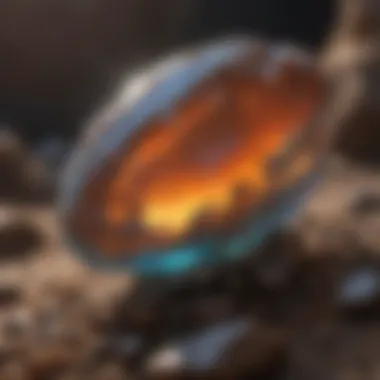Unveiling Opal's Mystique: A Deep Dive into Identification and Properties


Rock and Fossil Identification
Opals, exquisite gemstones formed from silica-rich solutions that have infiltrated cracks and voids in rocks, require keen observation to distinguish their unique characteristics. Understanding the types of opals and the distinct features they exhibit is paramount for enthusiasts and collectors alike. The play of colors, known as 'play-of-color,' is one of the defining traits of opals, with patterns ranging from pinfire to harlequin. Transparency and body tone are additional factors to consider when identifying opals, as they can greatly affect the gemstone's value. Utilizing tools such as magnifying loupes and UV lights proves indispensable in examining the intricacies of opals and deciphering their true nature.
Geological Insights
Delving into the geological aspects of opals unveils a world of fascination and complexity. From their formation in sedimentary environments to the intricate interplay of factors like temperature and pressure, opals offer a window into Earth's history and geological processes. Exploring the historical significance of opal mining regions provides insights into the evolution of gemstone production and the cultural impact of opals throughout the ages. Notable discoveries in the field of opal mining shed light on new techniques for extraction and the continuous exploration of opal-rich territories. Understanding the geological formations that favor opal deposition enhances appreciation for these extraordinary gemstones and enriches the collector's grasp of their inherent beauty and value.
Introduction to Opals
Opals, a mesmerizing gemstone with a rich history and unique properties, hold a significant place in the world of gemology. Understanding the intricacies of opal formation is essential for enthusiasts and collectors alike. By delving into the origins and scientific processes behind opal creation, we unlock the secrets of these captivating gemstones. The formation of opals is a complex and fascinating journey that involves various factors shaping their colors, patterns, and overall appearance. Exploring the types of opals, from precious to common and fire opals, provides insight into their diversity and allure, enriching our appreciation for these precious gemstones.
Understanding Opal Formation
Formation Process of Opals
The formation process of opals, characterized by the intricate interplay of silica spheres and water, gives rise to their dazzling play-of-color phenomenon. These silica spheres stack and diffract light, resulting in the vibrant hues and ethereal patterns that define opals. The formation process is a delicate dance of geological forces, where the conditions must be just right for opals to develop their unique optical properties. Understanding the formation process of opals unveils the meticulous craftsmanship of nature and the genesis of their enchanting allure.
Factors Influencing Opal Formation
Various factors influence opal formation, such as the presence of silica-rich solutions, geological upheavals, and the gradual deposition of mineral components. These influences determine the color intensity, play-of-color quality, and overall characteristics of opals. By exploring the factors that shape opal formation, we gain a deeper appreciation for the geological forces at play and the intricate processes that result in the creation of these splendid gemstones.
Types of Opals
Precious Opals
Precious opals, renowned for their vivid play-of-color and ethereal beauty, are highly prized in the world of gemstone enthusiasts. Their unique display of spectral colors, known as opalescence, sets them apart as one of the most coveted varieties of opals. The rarity and exceptional color play of precious opals make them a coveted treasure among collectors and connoisseurs, representing the pinnacle of opal perfection.
Common Opals
In contrast to precious opals, common opals exhibit a more subtle play-of-color or may lack this phenomenon altogether. However, common opals showcase a diverse range of colors and patterns, appealing to those seeking understated elegance in their gemstone collections. Their affordability and varied appearances make common opals a versatile choice for both novice and experienced collectors alike, offering a gateway into the enchanting world of opals.
Fire Opals
Fire opals, distinguished by their warm hues ranging from yellow to red, captivate the senses with their fiery brilliance. These opals derive their name from the intense play-of-color that resembles flickering flames within the gemstone. Fire opals exude a fiery energy and a vibrant charm, making them a dynamic addition to any gemstone collection. Their striking colors and luminous appeal establish fire opals as a captivating counterpart to the more traditional opal varieties.
Opal Characteristics
Color Variations in Opals
Opals display a vast spectrum of colors, ranging from delicate pastels to vivid hues, each reflecting the interplay of light and silica spheres within the gemstone. The wide array of colors found in opals adds to their allure and makes each stone a unique masterpiece of nature. Understanding the color variations in opals provides insight into their rarity, beauty, and desirability among gemstone enthusiasts.
Play-of-Color Phenomenon


The mesmerizing play-of-color phenomenon in opals, caused by the diffraction of light through the silica spheres, creates a kaleidoscopic display of spectral hues that dance across the gemstone's surface. This optical effect is a hallmark of opals, characterizing their enchanting beauty and mystical charm. The play-of-color phenomenon varies in intensity and pattern, giving each opal its individual character and captivating appeal.
Transparency and Clarity
Transparency and clarity are essential characteristics that influence the value and aesthetic appeal of opals. While some opals exhibit a transparent quality that allows light to pass through unhindered, others may possess varying degrees of opacity. The clarity of an opal affects its ability to showcase the play-of-color phenomenon and enhances its overall visual impact. Understanding the transparency and clarity of opals aids collectors and enthusiasts in appreciating the full beauty and quality of these captivating gemstones.
Opal Identification Techniques
Opal Identification Techniques play a crucial role in the comprehensive guide to deciphering opals by providing rock and fossil collectors with the tools to accurately discern the unique properties of this exquisite gemstone. Understanding visual examination, physical properties, and laboratory testing is essential for enthusiasts to make informed decisions about opals. By delving into opal identification techniques, collectors can unravel the secrets of opals and distinguish between natural and synthetic varieties.
Visual Examination
Color Analysis
Color Analysis is a vital aspect of opal identification techniques as it allows collectors to analyze the spectrum of colors present in the gemstone. By scrutinizing the color patterns and intensity, enthusiasts can determine the quality and rarity of the opal. Color Analysis is a popular choice in this article because it serves as a primary indicator of an opal's value and authenticity. The unique feature of Color Analysis lies in its ability to showcase the mesmerizing play-of-color phenomenon, adding to the opal's allure. Understanding Color Analysis's advantages and disadvantages can empower collectors to make informed decisions when evaluating opals.
Pattern Recognition
Pattern Recognition is another critical element in opal identification techniques, enabling collectors to identify unique patterns within the gemstone. By recognizing distinct swirls, dots, or lines, enthusiasts can distinguish between different types of opals. This section is beneficial for collectors as it provides key insights into the opal's origin and formation process. The unique feature of Pattern Recognition lies in its ability to unveil the opal's internal structure, aiding in authentication. Exploring the advantages and disadvantages of Pattern Recognition can enhance collectors' proficiency in evaluating opals.
Surface Features
Surface Features play a significant role in opal identification techniques, focusing on the external characteristics of the gemstone. By examining the surface texture, cracks, and inclusions, collectors can assess the opal's durability and authenticity. This aspect is a popular choice in the article as it provides valuable information about the opal's history and potential treatments. The unique feature of Surface Features lies in its ability to reveal the gemstone's past interactions with the environment, offering insights into its journey. Understanding the advantages and disadvantages of Surface Features can aid collectors in determining the quality and value of opals.
Physical Properties
Hardness and Toughness
Hardness and Toughness are essential aspects of opal identification techniques as they determine the gemstone's durability and resistance to scratches. By evaluating the hardness and toughness of an opal, collectors can assess its suitability for jewelry and daily wear. This section is a beneficial choice for the article as it sheds light on the opal's ability to withstand external forces and impacts. The unique feature of Hardness and Toughness lies in their correlation with the opal's rarity and value, influencing collectors' purchasing decisions. Exploring the advantages and disadvantages of Hardness and Toughness can equip enthusiasts with valuable knowledge when handling opal specimens.
Specific Gravity
Specific Gravity is a crucial component of opal identification techniques, focusing on the gemstone's density and weight in comparison to water. By measuring the specific gravity, collectors can differentiate between opal varieties and assess their authenticity. This topic is a popular choice in this article as it provides insights into the opal's composition and potential enhancements. The unique feature of Specific Gravity lies in its ability to reveal the opal's purity and natural state, guiding collectors in their valuation process. Understanding the advantages and disadvantages of Specific Gravity can enhance collectors' proficiency in determining the quality and value of opals.
Cleavage and Fracture
Cleavage and Fracture are essential considerations in opal identification techniques, focusing on the gemstone's internal structure and susceptibility to breakage. By examining the cleavage and fracture patterns, collectors can assess the opal's stability and handling requirements. This section is a beneficial choice for the article as it highlights the opal's vulnerability to external impacts and stresses. The unique feature of Cleavage and Fracture lies in their impact on the gemstone's durability and longevity, influencing collectors' care and maintenance practices. Exploring the advantages and disadvantages of Cleavage and Fracture can empower enthusiasts with the necessary skills to preserve and protect their opal collections.
Laboratory Testing
Spectroscopy
Spectroscopy plays a vital role in opal identification techniques, utilizing light absorption and emission patterns to analyze the gemstone's composition. By using spectroscopic techniques, collectors can identify trace elements and potential enhancements in the opal. This method is a beneficial choice in this article as it offers precise and objective results, supporting collectors in their authentication process. The unique feature of Spectroscopy lies in its ability to uncover subtle differences between opal varieties, aiding in classification and valuation. Understanding the advantages and disadvantages of Spectroscopy can enhance collectors' confidence in discerning natural opals from synthetic or treated alternatives.


X-ray Diffraction
X-ray Diffraction is a valuable tool in opal identification techniques, providing insights into the gemstone's crystal structure and arrangement. By utilizing X-ray diffraction patterns, collectors can determine the opal's mineral composition and potential impurities. This technique is a popular choice in this article as it offers detailed information about the opal's internal characteristics and formation process. The unique feature of X-ray Diffraction lies in its ability to reveal the opal's unique lattice arrangement, aiding in geographic origin determination. Exploring the advantages and disadvantages of X-ray Diffraction can enrich collectors' understanding of the scientific principles behind opal formation and identification.
Microscopy
Microscopy is an essential method in opal identification techniques, allowing collectors to examine the gemstone's internal structure and inclusions at a microscopic level. By using microscopy, enthusiasts can detect irregularities, fractures, and growth patterns in the opal. This approach is a beneficial choice for the article as it provides detailed insights into the gemstone's quality and authenticity. The unique feature of Microscopy lies in its ability to unveil the opal's hidden characteristics, such as play-of-color distribution and internal fractures. Understanding the advantages and disadvantages of Microscopy can equip collectors with the necessary skills to evaluate opals with precision and accuracy.
Opal Imitations and Treatments
Opal imitations and treatments play a pivotal role in the realm of opals, adding a layer of complexity to the identification process. Understanding the nuances of synthetic opals and various treatments is crucial for enthusiasts and collectors to differentiate between natural and enhanced gemstones. By delving into this topic, readers gain valuable insights into the potential alterations that opals undergo, shedding light on factors that can impact their value and authenticity.
Synthetic Opals
Characteristics of Synthetic Opals
In the intricate world of opals, the characteristics of synthetic opals stand out as a significant aspect to explore. Synthetic opals replicate the unique beauty of natural opals through controlled manufacturing processes. One key characteristic of synthetic opals is their consistent coloration and play-of-color patterns, which can be precisely controlled during production. This consistency makes synthetic opals a popular choice for jewelry makers and collectors seeking affordable yet visually striking gemstones. However, the lack of natural rarity and uniqueness may be considered a disadvantage for purists and connoisseurs of natural opals.
Distinguishing Natural and Synthetic Opals
Distinguishing between natural and synthetic opals is a critical skill for gemstone enthusiasts. One key characteristic in this aspect is the presence of inclusions or imperfections unique to natural opals, which may not be found in synthetic counterparts. Understanding these distinguishing features aids in verifying the authenticity of opals, ensuring that collectors are acquiring genuine gemstones. While synthetic opals offer affordability and consistency, the lack of natural imperfections can be a drawback for those valuing the organic beauty and authenticity of natural opals.
Opal Treatments
Common Treatments
The world of opals encompasses various treatments aimed at enhancing their visual appeal or durability. Common treatments such as stabilization through resin infusion or enhancement through sugar solutions can affect an opal's appearance and longevity. One key characteristic of these treatments is their ability to improve the opal's color vibrancy and overall aesthetic appeal. Jewelry designers often choose treated opals for their versatility and affordability, bringing stunning creations to life. However, the reliance on treatments may raise concerns among purists who prefer the inherent beauty of untreated, natural opals.
Impact on Value
Opal treatments have a direct impact on the value of gemstones, influencing their desirability among collectors and buyers. The key characteristic in this realm is how treatments can potentially elevate an opal's appearance, making it more visually appealing and commercially viable. While treatments may enhance an opal's market value by improving its aesthetics, there is a discernible impact on its authenticity and long-term value. Understanding the implications of treatments on opal value is essential for making informed decisions when acquiring these stunning gemstones.
Opal Grading and Valuation
Opal grading and valuation hold immense significance within the domain of opals, underscoring the meticulous process of assessing and assigning value to these captivating gemstones. In this section, we delve into the specific elements and considerations vital for understanding opal grading and valuation, guiding collectors and enthusiasts towards informed decisions.
Factors Affecting Opal Value
Color Intensity
Color intensity plays a pivotal role in determining the value of opals, with vibrant and striking hues commanding greater attention and value in the market. The richness and depth of color intensity in opals directly influence their overall appeal and desirability, making them highly sought after by collectors. Understanding the nuances of color intensity is essential for appraising opals accurately, as it often signifies the gem's rarity and uniqueness, contributing significantly to its overall value.
Pattern Rarity


The rarity of patterns exhibited by opals contributes significantly to their allure and value within the gemstone industry. Unique and intricate patterns add a distinct charm to opals, capturing the fascination of collectors worldwide. Opals boasting rare and exceptional patterns are highly coveted, commanding premium prices in the market. Evaluating pattern rarity showcases the distinctive qualities of opals, highlighting their individuality and desirability among enthusiasts.
Clarity and Transparency
Clarity and transparency are paramount considerations when assessing the value of opals, as these characteristics define the gem's quality and visual appeal. Opals with high clarity and transparency exhibit clear and flawless structures, enhancing the play-of-color phenomenon and overall aesthetic allure. The transparency of opals influences their light transmission properties, impacting the intensity of color play and brilliance. Evaluating clarity and transparency aids in distinguishing superior opals and determining their valuation accurately.
Grading Systems
GIA Opal Grading
The Gemological Institute of America (GIA) opal grading system provides a comprehensive framework for evaluating opals based on their color, clarity, and other significant attributes. Recognized globally for its stringent standards and expertise, GIA opal grading offers valuable insights into the quality and authenticity of opals. Utilizing the GIA grading system enhances transparency and trust in the opal market, enabling collectors to make informed decisions and investments with confidence.
Other Grading Scales
Various other grading scales are employed in the gemstone industry to assess opals based on distinct criteria and characteristics. These alternative grading scales offer diverse perspectives on opal valuation, catering to specific preferences and market demands. Understanding and comparing different grading scales provide collectors with a comprehensive outlook on opal quality and value, facilitating informed choices and negotiations in the trade.
Valuation Considerations
Market Trends
Monitoring and analyzing market trends are essential components of opal valuation, providing valuable insights into consumer preferences, demand fluctuations, and pricing dynamics. Staying attuned to evolving market trends empowers collectors to make strategic decisions regarding opal acquisitions and sales, aligning with current market demands and opportunities. By interpreting market trends effectively, collectors can optimize their investment strategies and navigate the competitive landscape with agility.
Authenticity Verification
Authenticity verification stands as a critical aspect of opal valuation, ensuring the legitimacy and integrity of gemstones in the market. Implementing rigorous authenticity checks and verification processes safeguards collectors against counterfeit or enhanced opals, preserving the value and reputation of their collections. Validating the authenticity of opals instills trust and confidence in buyers and sellers, reinforcing ethical practices and transparency within the gemstone industry.
Opal Care and Maintenance
Opal Care and Maintenance is a critical aspect covered in this comprehensive guide to opal identification. Understanding how to properly care for and maintain opals is crucial in preserving their beauty and quality over time. Enthusiasts and collectors must pay close attention to the care regimen to ensure longevity and optimal appearance. By following recommended practices, individuals can protect their opals from damage and degradation, safeguarding their value and aesthetics.
Cleaning Practices
Safe Cleaning Methods
Safe Cleaning Methods play a pivotal role in the maintenance of opals. These methods involve gentle and non-abrasive techniques that effectively remove dirt and residues without harming the gemstone. The key characteristic of Safe Cleaning Methods is their ability to cleanse opals thoroughly without causing scratches or abrasions. This gentle approach is highly beneficial for opals as it ensures their delicate surfaces remain unharmed. The unique feature of Safe Cleaning Methods lies in their ability to deliver effective cleaning results while maintaining the integrity of the opal, making them a preferred choice for enthusiasts seeking to preserve the brilliance of their gemstones.
Avoiding Damage
Avoiding Damage is a critical consideration when caring for opals. By understanding how to prevent harm during cleaning and storage, individuals can mitigate the risk of accidental damage to their precious stones. The key characteristic of Avoiding Damage is its emphasis on precautionary measures to safeguard opals from scratches, impacts, and environmental stressors. This proactive approach significantly reduces the chances of detrimental outcomes and ensures the longevity of opals. While there are certain limitations to opal durability, implementing strategies to avoid damage is paramount in maintaining their pristine condition throughout the years.
Storage Tips
Proper Storage Conditions
Proper Storage Conditions are essential for preserving the quality of opals. Maintaining opals in controlled environments with stable temperature and humidity levels is crucial to prevent degradation and color alteration. The key characteristic of Proper Storage Conditions is their ability to create an ideal setting that prolongs the lifespan of opals by minimizing exposure to adverse elements. By storing opals in suitable conditions, collectors can prevent unnecessary damage and maintain the gemstone's natural beauty. The unique feature of Proper Storage Conditions lies in their capacity to shield opals from environmental factors that could compromise their integrity, making them an indispensable component of opal care.
Protection from Elements
Protection from Elements is a key aspect of opal care that focuses on shielding gemstones from external hazards. Opals are sensitive to sudden temperature changes, high humidity, and exposure to chemicals, necessitating protective measures to safeguard their brilliance. The key characteristic of Protection from Elements is its role in creating barriers against harmful agents that could harm opals. By implementing strategies to shield opals from environmental threats, collectors can minimize the risk of damage and preserve the gemstone's visual appeal. The unique feature of Protection from Elements is its ability to defend opals from a range of potentially damaging factors, ensuring their longevity and value over time.







